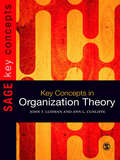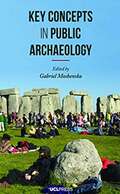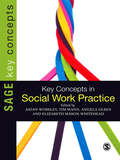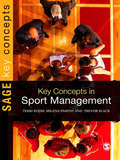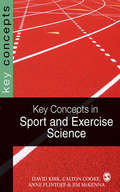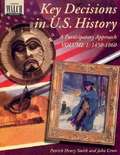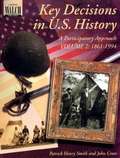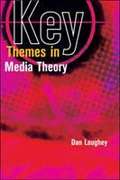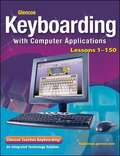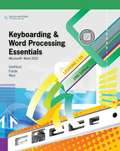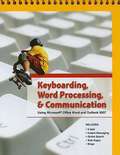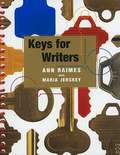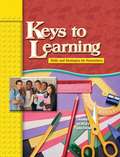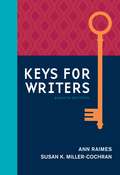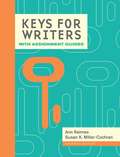- Table View
- List View
Key Concepts in Operations Management (SAGE Key Concepts series)
by Michel LeseureKey Concepts in Operations Management introduces a selection of key concepts and techniques in the field.<P> Concise, informative and contemporary, with consideration given to explaining the principles of the topic, as well as the relevant debates and literature, the book contains over 50 concept entries including: Operations Strategy, Managing Innovation, Process Modeling, New Product Development, Forecasting, Planning and Control, Supply Chain Management, Risk Management and many more.
Key Concepts in Organization Theory (SAGE Key Concepts series)
by John Teta Luhman Ann L CunliffeFrom agency theory to power and politics, this indispensable guide to the key concepts of organization theory is your compass as you navigate through the often complex and abstract theories about the design and functioning of organizations. Designed to complement and elucidate your textbook or reading list, as well as introduce you to concepts that some courses neglect, this historical and interdisciplinary account of the field:<P><P> - Helps you understand the basics of organization theory<P> - Allows you to check your understanding of specific concepts<P> - Fills in any gaps left by your course reading, and<P> - Is a powerful revision tool<P> Each entry is consistently structured, providing a definition of the concept and why it's important to theory and practice, followed by a summary of current debates and a list of further reading. This companion will provide you with the nuts and bolts of an understanding that will serve you not just in your organization studies course, but throughout your degree and beyond.<P> Key concepts include: agency theory; business strategy; corporate governance; decision making; environmental uncertainty; globalization; industrial democracy; organizational change; stakeholder theory; storytelling and narrative research; technology and organization structure.
Key Concepts in Public Archaeology
by Gabriel MoshenskaThis book provides a broad overview of the key concepts in public archaeology, a research field that examines the relationship between archaeology and the public, in both theoretical and practical terms. While based on the long-standing programme of undergraduate and graduate teaching in public archaeology at UCL’s renowned Institute of Archaeology, the book also takes into account the growth of scholarship from around the world and seeks to clarify what exactly ‘public archaeology’ is by promoting an inclusive, socially and politically engaged vision of the discipline. <p><p> Written for students and practitioners, the individual chapters provide textbook-level introductions to the themes, theories and controversies that connect archaeology to wider society, from the trade in illicit antiquities to the use of digital media in public engagement, and point readers to the most relevant case studies and learning resources to aid their further study. <p><p> This book was produced as part of JISC's Institution as e-Textbook Publisher project. Find out more at https://www.jisc.ac.uk/rd/projects/institution-as-e-textbook-publisher
Key Concepts in Social Work Practice (SAGE Key Concepts series)
by Elizabeth Mason-Whitehead Angela Olsen Tim Mann Aidan WorsleyThis book is a quick and accessible reference guide to the key concepts that social work students and professionals need to understand to be effective. The authors place practice at the centre of the text, and include a host of case examples to bring the concepts to life. Examining the essential topics of the social work curriculum, the concepts covered relate to practice, theory, policy and personal challenges. Further reading is included in each entry, so that the reader can explore what they have learned in more detail. This book will be an invaluable resource for social work students during their studies and on their practice placement. It will also be useful for qualified social workers, who want to continue their professional education.
Key Concepts in Sport Management (SAGE Key Concepts series)
by Milena Parent Terri Byers Trevor Slack"An accessible and different guide for students and practitioners alike... I'm sure that it will become a standard reference text for sports management" - Peter Taylor, Sport Industry Research Centre, Sheffield Hallam University "A must have introductory reference guide for graduate and undergraduate sport management students" - Paul M. Pedersen, Indiana University "Provides students, practitioners and researchers in the field of sport management with a valuable compilation of sensitizing concepts, definitions and interesting references" - Michel van Slobbe, European Sport Management Quarterly Sharp, clear and relevant this book meets the needs of those studying and researching within the growing discipline of sport management. The intelligently cross-referenced entries provide a concise overview of the key concepts in the field guiding you through the important debates, sources and research methods in the management and delivery of sport. The book introduces readers to the concepts at the centre of their studies; it suggests relevant further reading and thoughts for future research and applies academic theory to business and organizational problems in a real-world context. Written for students, academics and practitioners the entries are designed to meet study needs and include: Clear definitions Comprehensive examples Practical applications Effective research methods.
Key Concepts in Sport and Exercise Sciences (SAGE Key Concepts series)
by David Kirk Jim Mckenna Anne Flintoff Carlton B. Cooke'A very useful introduction to the key concepts in five main areas of study in sport and exercise science. The multi-disciplinary nature of the book is particularly attractive as it means that it can be used to support students studying a range of sport and exercise courses and modules. Furthermore, the chapters are concise, informative, written in an accessible style, and provide a good balance between theory and application to practice, making it a very interesting and relevant read' - Dr Lorraine Cale, Loughborough University This book provides students and scholars with a fail-safe guide to the key concepts in the field of Sport & Exercise Science. Intelligently cross-referenced entries provide a sound map of the multi-disciplinary demands of sport related courses including physical and biological sciences, social science and education. The entries use clear definitions, examples and suggestions for further reading to explore each discipline and are: " Comprehensive " Lucid " Pertinent to study needs " Practically relevant David Kirk is Professor in Physical Education and Youth Sport Carlton Cooke is Professor in Physical Education Anne Flintoff is Reader in Physical Education Jim McKenna is Professor in Physical Activity and Health All at the Carnegie Faculty of Sport and Education, Leeds Metropolitan University.
Key Decisions In U. S. History: 1450-1860
by John Croes Patrick Henry SmithPromotes critical-thinking and decision-making skills through comprehension activities. Focuses on key decisions and provides background to fuel informed discussion.
Key Decisions In U. S. History: A Participatory Approach (Vol. 2 -- 1861-1994)
by John Croes Patrick Henry SmithPromotes critical-thinking and decision-making skills through comprehension activities Focuses on key decisions and provides background to fuel informed discussion.
Key Issues in Education Policy (Education Studies: Key Issues)
by Stephen Ward Christine E. Eden'Ward and Eden have produced a useful and elegant text which deserves a place on the reading list of any education degree. I certainly hope that its readership goes beyond the most obvious target audience, as anyone involved in education would do well to read and enjoy this text' - ESCalate 'Education Policy is increasingly complex and opaque - this timely book brings clarity and reason to bear and is an ideal starting point for students and teachers struggling to understand the political world in which they work' - Professor Stephen J Ball, Institute of Education, University of London What effect has two decades of intensive state direction and government involvement had on education? Designed for Education Studies students who have probably grown up in this context of government intervention, this book deconstructs accepted notions and provides readers with the resources to discuss critically the role of the governments in education and schooling. The book examines government policy in a series of key areas, such as the curriculum, market forces, educational inequality and race issues. Throughout it considers the political and economic factors in education policy, introducing some of the fundamental concepts required to analyse the ideologies of education and the state. The authors explore the role of education policy in the context of the general direction of government policy, politics and the economy, making links with other policy areas such as health, social services, home affairs and foreign policy. They also explain the nature of government policy in terms of a globalization and the knowledge economy.
Key Themes in Media Theory
by Dan LaugheyKey Themes in Media Theory provides a thorough and critical introduction to the key theories of media studies. It is unique in bringing together different schools of media theory into a single, comprehensive text, examining in depth the ideas of key media theorists such as Lasswell, McLuhan, Hall, Williams, Barthes, Adorno, Baudrillard and Bourdieu. Using up-to-date case studies the book embraces media in their everyday cultural forms – music, internet, film, television, radio, newspapers and magazines – to enable a clearer view of the ‘big picture’ of media theory. In ten succinct chapters Dan Laughey discusses a broad range of themes, issues and perspectives that inform our contemporary understanding of media production and consumption. With images and diagrams to illustrate chapter themes, examples that apply media theory to media practice, recommended reading at the end of every chapter, and a useful glossary of key terms, this book is the definitive guide to understanding media theory.
Keyboarding with Computer Applications: Lessons 1-150
by Jack E. Johnson Delores Sykes Cotton Carole Glosup Stanley Judith Chiri-MulkeyThis book will appeal to every student. All elements, including the courseware, textbook, and student software manuals are fully integrated to provide students with the total learning experience.
Keyboarding and Word Processing Essentials: Microsoft Word 2010 (18th Edition)
by Susie H. Vanhuss Connie M. Forde Donna L. WooThe Eighteenth Edition of KEYBOARDING AND WORD PROCESSING ESSENTIALS, LESSONS 1-55 uses proven techniques to help readers master the keyboarding and formatting skills they need for career success-from initial new-key learning to expertise in formatting business documents with Microsoft Word 2010. South-Western College Keyboarding offers a proven, time-tested approach that helps readers develop a strong foundation in basic keyboarding, steadily improve their skills, and rapidly become proficient in document formatting and business communication. Each lesson is clearly focused, well structured, and designed to provide step-by-step training and reinforcement to help readers quickly acquire and apply new skills. This one-book solution includes 55 lessons, documents, and software instructions within a space-saving easel-back format.
Keyboarding, Word Processing, & Communication: Using Microsoft® Office Word and Outlook 2007
by Pearson EducationNIMAC-sourced textbook
Keys For Writers (Sixth Edition)
by Ann Raimes Maria JerskeyWith its simple tabbing system (five red tabs for the writing process and research, and five gold tabs for sentence-level topics), thorough and concise coverage of grammar, an easy-to-read format, and customizable KeyTabs, KEYS FOR WRITERS is a valuable resource for students in all disciplines throughout their college careers and beyond. In addition to a contemporary new design, an entirely new companion website, and a new media-enhanced e-Book, the Sixth Edition features updates and additions including new visuals, more of the book's popular "Source Shots," new student samples, MLA and APA coverage thoroughly revised to reflect their respective organizations' latest standards, and expanded coverage of topics ranging from annotated bibliographies and working with sources to visual arguments. This is an extensive and exciting revision of an effective handbook that is deservedly a best-seller!
Keys To Learning: Skills And Strategies For Newcomers
by Anna Uhl Chamot Kristina A. Anstrom Catharine W. KeatleyKeys to Learning: Skills and Strategies for Newcomers, by Anna Uhl Chamot, Catharine W. Keatley, and Kristina Anstrom, provides middle and high school newcomers with the skills and strategies to make a great start in reading, writing, and grammar. Research-based and standards-driven,Keys to Learninggives newcomers step-by-step tools for developing their academic skills and becoming successful lifelong learners. Using a four-skills approach, students gain solid foundation in essential skills and strategies through authentic literature and informational readings. Keys to Learningbuilds skills and experiences needed to develop literacy and bring students up to speed for academic learning.
Keys for Writers (8th Edition)
by Ann Raimes Susan K. Miller-CochranOffering a wealth of examples, tips, and tools, KEYS FOR WRITERS, 8e, is an easy-to-use resource for improving your writing for all of your coursework -- as well as your career. Color-coded tabs allow you to quickly find answers to your grammar and writing questions. The visual Critical Thinking Framework enables you to read, write, and research with better results, and Key Examples help you compare strong versus weak ways of applying critical thinking. Sample student papers provide excellent models of writing in different disciplines, while the new Assignment Guide provides steps for writing in 15 common genres you might encounter in your academic and professional career. Completely up to date with the latest MLA guidelines, the eighth edition also highlights the importance of writing in such careers as nursing, accounting, law, IT, and more.
Keys for Writers with Assignment Guides (7th Edition)
by Ann Raimes Susan Miller-CochranThe seventh edition of Keys for Writers welcomes the substantial contributions of Susan Miller-Cochran as a coauthor. Susan is an Associate Professor of English and Director of the First-Year Writing Program at North Carolina State University. She earned a master's degree in teaching English as a Second Language and a doctoral degree in rhetoric and composition at Arizona State University. In addition to her writing program administration experience, she has also taught writing and ESL courses at a community college, in adult education programs, and abroad. She is also a coauthor of the Wadsworth Guide to Research. We are delighted to be working together and pooling our experience and expertise for this new edition.
Khel Yatra (Physical Education And Well-being Textbook) class 6 - NCERT - 25
by National Council of Educational Research and TrainingKhel Yatra is a Physical Education and Well-being textbook designed for Grade 6 students by NCERT, aligning with the National Curriculum Framework for School Education (NCF-SE) 2023. The book aims to promote holistic development by integrating physical fitness, emotional balance, and social well-being. It introduces students to the joy of movement, teamwork, and discipline through engaging activities and traditional Indian games. The textbook is divided into five main units—Importance of Physical Education and Well-being, Motor Fitness, Fundamental Skills of Kho-Kho, Fundamental Skills of Handball, and Yoga. Each unit focuses on developing specific physical and mental skills. Students learn endurance, strength, flexibility, and balance while also understanding teamwork, safety, and empathy through interactive exercises and circle time reflections. The inclusion of Indian sports like Kho-Kho helps children connect with cultural roots, while Handball enhances coordination and team spirit. Yoga, being a vital part of the curriculum, teaches self-discipline, focus, and mindfulness through Asanas, Pranayama, and Dhyana. The book also emphasizes inclusion, gender equality, and respect for others, encouraging students to stay fit, confident, and compassionate. Overall, Khel Yatra provides a structured, joyful, and holistic approach to physical education, preparing students for a healthy and active lifestyle.
Khel Yatra (Physical Education And Well-being Textbook) class 8 - NCERT - 25
by National Council of Educational Research and TrainingKhel Yatra: Physical Education and Well-being is NCERT’s Grade 8 textbook developed under the National Curriculum Framework for School Education (NCF-SE) 2023 to promote holistic physical, mental, and emotional development. The book blends theory and practice through six comprehensive units—Foundations of Physical Education, Physical and Motor Fitness, Athletics, Table Tennis, Volleyball, and Yoga—emphasising fitness, teamwork, and mindfulness. It integrates scientific concepts from physics and biology with interactive games and reflective “circle time” discussions to cultivate discipline, resilience, inclusivity, and respect. By aligning with NEP 2020’s vision of experiential and value-based education, Khel Yatra encourages students to explore physical activity as a joyful, lifelong practice for health, well-being, and social harmony.
Khel Yog (Sanskrit language) class 3 - NCERT - 25: खेलयोग ३रीं कक्षा - एनसीईआरटी - २५
by Rashtriy Shaikshik Anusandhan Aur Prashikshan Parishadखेल और योग कक्षा 3 के विद्यार्थियों के लिए एक उपयोगी पुस्तक है जो उनके शारीरिक, मानसिक और नैतिक विकास को बढ़ावा देती है। यह पुस्तक खेल-कूद, योगाभ्यास और शारीरिक गतिविधियों के माध्यम से विद्यार्थियों में अनुशासन, एकता, आत्म-नियंत्रण और सहयोग की भावना को विकसित करती है। इसमें सरल भाषा में विविध खेलों, योगासनों और व्यायामों का परिचय दिया गया है ताकि बच्चे इन्हें सहज रूप से समझ सकें और अभ्यास कर सकें। पुस्तक में चित्रों, गतिविधियों और समूह कार्यों के माध्यम से विद्यार्थियों की भागीदारी और रुचि को बढ़ाया गया है। यह पाठ्यक्रम न केवल स्वास्थ्यवर्धक जीवनशैली की दिशा में प्रेरित करता है, बल्कि विद्यार्थियों को सक्रिय, आत्मविश्वासी और स्वस्थ नागरिक बनने के लिए भी प्रेरित करता है।
Khel Yog (Sharirik Shiksha aur Arogya) class 3 - NCERT - 25: खेल योग (शारीरिक शिक्षा और आरोग्य) ३रीं कक्षा - एनसीईआरटी - २५
by Rashtriy Shaikshik Anusandhan Aur Prashikshan Parishadखेल और योग कक्षा 3 के विद्यार्थियों के लिए एक उपयोगी पुस्तक है जो उनके शारीरिक, मानसिक और नैतिक विकास को बढ़ावा देती है। यह पुस्तक खेल-कूद, योगाभ्यास और शारीरिक गतिविधियों के माध्यम से विद्यार्थियों में अनुशासन, एकता, आत्म-नियंत्रण और सहयोग की भावना को विकसित करती है। इसमें सरल भाषा में विविध खेलों, योगासनों और व्यायामों का परिचय दिया गया है ताकि बच्चे इन्हें सहज रूप से समझ सकें और अभ्यास कर सकें। पुस्तक में चित्रों, गतिविधियों और समूह कार्यों के माध्यम से विद्यार्थियों की भागीदारी और रुचि को बढ़ाया गया है। यह पाठ्यक्रम न केवल स्वास्थ्यवर्धक जीवनशैली की दिशा में प्रेरित करता है, बल्कि विद्यार्थियों को सक्रिय, आत्मविश्वासी और स्वस्थ नागरिक बनने के लिए भी प्रेरित करता है।
Khel Yog (Sharirik Shikshan ani Kalyan) class 3 - NCERT - 25: खेल योग (शारिरीक शिक्षण आनी कल्याण ) ३रीं कक्षा - एनसीईआरटी - २५
by Rashtriy Shaikshik Anusandhan Aur Prashikshan Parishadखेल और योग कक्षा 3 के विद्यार्थियों के लिए एक उपयोगी पुस्तक है जो उनके शारीरिक, मानसिक और नैतिक विकास को बढ़ावा देती है। यह पुस्तक खेल-कूद, योगाभ्यास और शारीरिक गतिविधियों के माध्यम से विद्यार्थियों में अनुशासन, एकता, आत्म-नियंत्रण और सहयोग की भावना को विकसित करती है। इसमें सरल भाषा में विविध खेलों, योगासनों और व्यायामों का परिचय दिया गया है ताकि बच्चे इन्हें सहज रूप से समझ सकें और अभ्यास कर सकें। पुस्तक में चित्रों, गतिविधियों और समूह कार्यों के माध्यम से विद्यार्थियों की भागीदारी और रुचि को बढ़ाया गया है। यह पाठ्यक्रम न केवल स्वास्थ्यवर्धक जीवनशैली की दिशा में प्रेरित करता है, बल्कि विद्यार्थियों को सक्रिय, आत्मविश्वासी और स्वस्थ नागरिक बनने के लिए भी प्रेरित करता है।
Khel Yog (Sharirik Shikshan ani Kalyan) class 3 - NCERT - 25: खेळ योग (शारिरीक शिक्षण आणि कल्याण ) इयत्ता ३रीं - एनसीईआरटी - २५
by Rashtriy Shaikshik Anusandhan Aur Prashikshan Parishad“खेळ योग” या पुस्तकात योगशास्त्र व खेळ या दोन महत्त्वाच्या अंगांचा समन्वय साधण्याचा प्रयत्न केला आहे. शरीराची तंदुरुस्ती, मानसिक संतुलन व एकाग्रता ही दोन्ही क्षेत्रांची समान ध्येये आहेत. लेखकाने सोप्या भाषेत योगाभ्यासाचे महत्त्व, त्यातील विविध आसने, प्राणायाम व ध्यान यांचे स्पष्टीकरण केले आहे. खेळाडूंना उत्तम कामगिरी करण्यासाठी नियमित योगाभ्यास कसा उपयुक्त ठरतो हे दाखवले आहे. पुस्तकात खेळाडूंच्या शारीरिक क्षमतेबरोबरच मानसिक तयारीलाही विशेष महत्त्व दिले आहे. योगामुळे मनःशांती मिळते, ताणतणाव कमी होतो, एकाग्रता वाढते आणि आत्मविश्वास दृढ होतो. यामुळे खेळाडूंना स्पर्धात्मक वातावरणात आपली सर्वोत्तम क्षमता दाखवता येते. तसेच विविध खेळांमध्ये होणाऱ्या दुखापती टाळण्यासाठी व शरीर लवचिक ठेवण्यासाठी योग किती आवश्यक आहे हेही समजावून सांगितले आहे. लेखकाने शालेय विद्यार्थ्यांपासून व्यावसायिक खेळाडूपर्यंत सर्वांसाठी उपयुक्त असे मार्गदर्शन दिले आहे. निरोगी जीवनशैली अंगीकारण्यासाठी योग व खेळ यांचा संगम कसा साधावा हे पुस्तक ठोसपणे अधोरेखित करते.
Khel Yoga (Physical Education And Well-being Textbook) class 3 - NCERT-25
by National Council of Educational Research and Training“Khel Yoga” is a Class 3 textbook developed by NCERT to promote physical education and holistic well-being among young learners. It focuses on developing motor skills, introducing students to traditional Indian games, and initiating them into age-appropriate yogic practices. The book is divided into three units—Basic Motor Movements, Our Games, and Yoga—each filled with engaging, playful activities that foster physical fitness, emotional resilience, cooperation, and cultural rootedness. It promotes peer learning and encourages children to play with friends and family while instilling values like empathy, discipline, and teamwork. Through structured sessions and reflective "Circle Time," students not only enhance physical abilities but also develop social and emotional intelligence. The textbook also integrates safety practices, inclusive participation, and thoughtful planning to ensure an enriching and joyful learning experience. It serves as a valuable resource for teachers, students, and parents alike, contributing to the overall development of a healthy, happy child.

